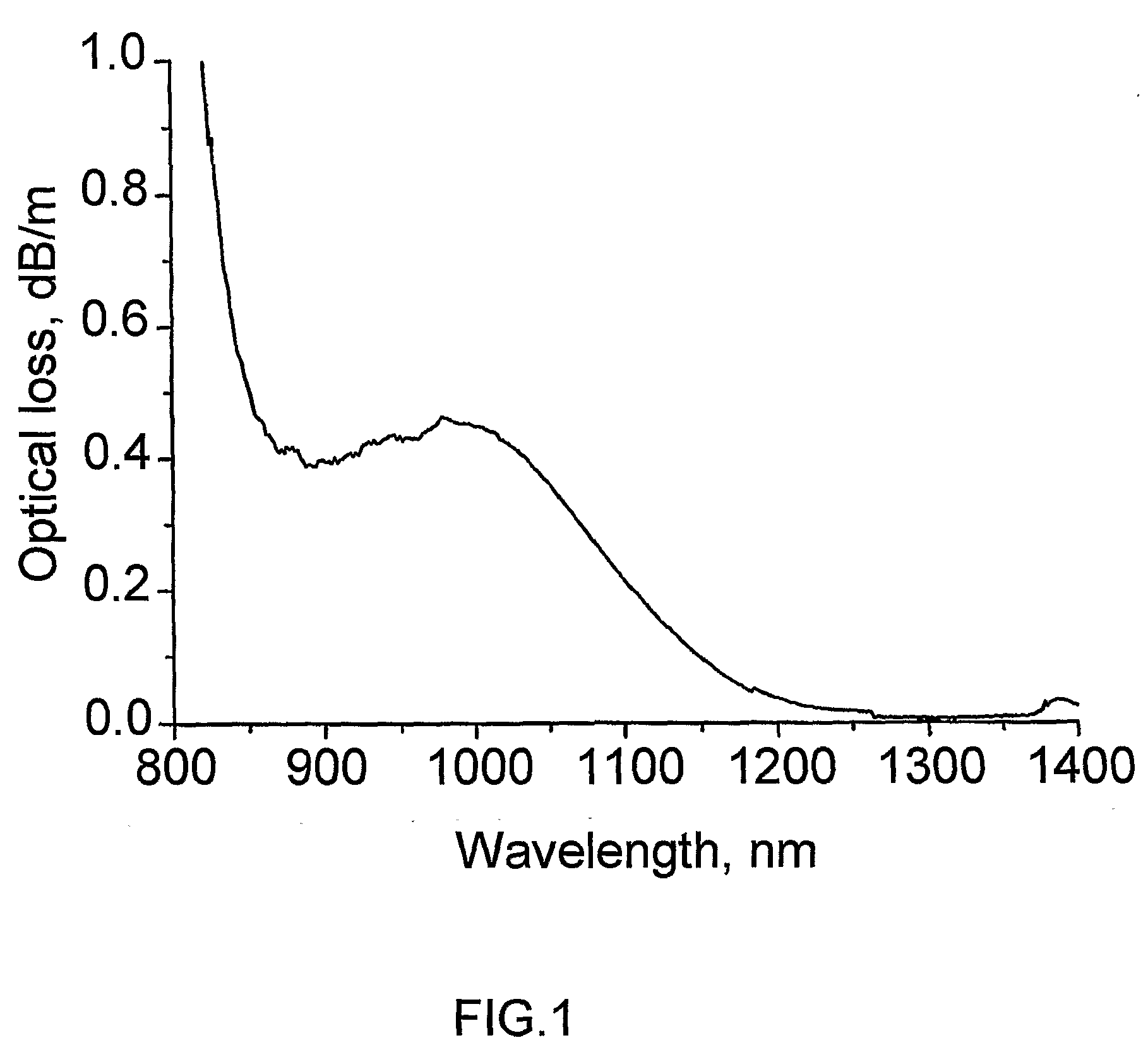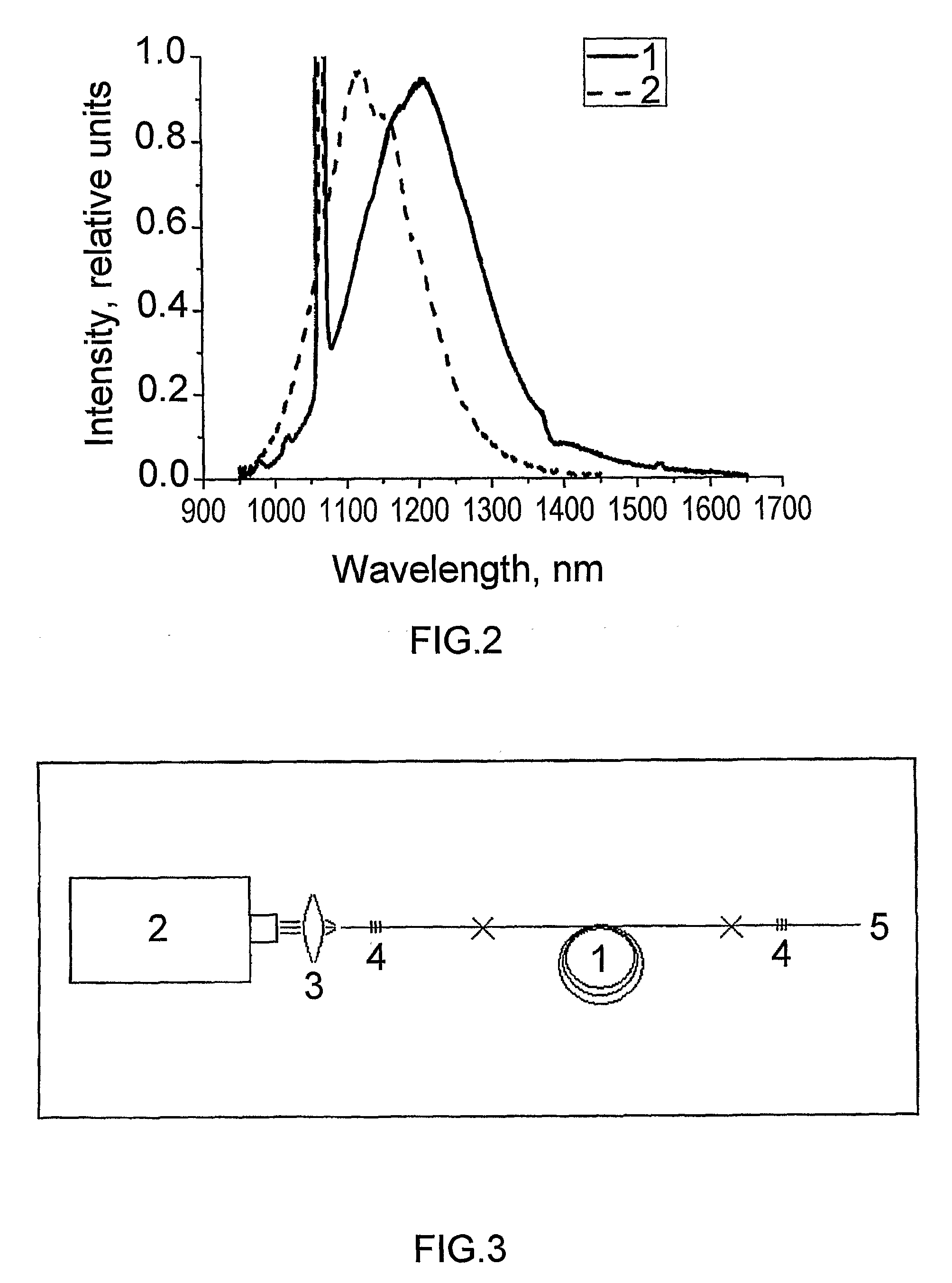Amplifying Optical Fiber Operating At A Wavelength In The Range Of 1000-1700 nm, Methods of Fabricating The Same, And Fiber Laser
a technology of optical fiber and wavelength, applied in the field of fiber optics, can solve the problems of high optical loss, prohibit the creation of amplifiers, and the inability to conclude from published data whether, and achieve the effect of extending the amplification band width and efficient amplification
- Summary
- Abstract
- Description
- Claims
- Application Information
AI Technical Summary
Benefits of technology
Problems solved by technology
Method used
Image
Examples
example 1
[0104]Lasing was demonstrated using an optical fiber with a core consisting of silicon oxide, aluminum oxide and bismuth oxide at wavelengths of 1150, 1215, 1250 and 1300 nm with pumping at the 1064 nm wavelength. Bragg gratings were used to form a resonator (FIG. 3). The gratings were written on standard germanium-silicate fibers, wherein output gratings had the reflection factor of 3 dB and mating gratings had a high reflection factor greater than 20 dB.
[0105]The maximum output power obtained at a pump power of about 2.5 W was 460 mW at the wavelength 1150 nm and 400 mW at the wavelength 1215 nm.
[0106]In case of lasing at 1150 nm the lasing threshold was 210 mW, while the differential efficiency was 20.4% on the input power basis. In case of lasing at 1215 nm the threshold was 495 mW with the differential efficiency of 28.6%. These values are in a good agreement with theoretical data and may be considerably improved in practice by:
[0107]a) using the optical fibers with written gra...
example 2
[0110]Lasing was investigated in the range of 1120-1220 nm in a laser circuit (FIG. 4) with an optical fiber coupler 6 used to form a resonator. The coupler 6 was made on the basis of a standard germanium-silicate fiber. The resulting resonator had a high reflection factor (greater than 80%) in the 1.1-1.2 nm band. The active fiber had a fused quartz cladding and a core consisting of SiO2, Al2O3, Bi2O3. FIGS. 5a and 5b show lasing spectra obtained in the laser with pumping at 1064 nm. Owing to small selectivity of the resonator, when the lasing threshold was slightly exceeded the lasing occurred at once at a plurality of longitudinal modes, while the spectral position of peaks is unstable, i.e. “free lasing” regime was realized. With increasing the pump power the number of peaks decreased, but actually one maximum remained in the 1170 nm region when the threshold was considerably exceeded (FIG. 5b).
[0111]As shown in FIG. 5a, the free regime lasing occurred in a band with about 100 n...
PUM
| Property | Measurement | Unit |
|---|---|---|
| half-height width | aaaaa | aaaaa |
| half-height width | aaaaa | aaaaa |
| wavelengths | aaaaa | aaaaa |
Abstract
Description
Claims
Application Information
 Login to View More
Login to View More - R&D
- Intellectual Property
- Life Sciences
- Materials
- Tech Scout
- Unparalleled Data Quality
- Higher Quality Content
- 60% Fewer Hallucinations
Browse by: Latest US Patents, China's latest patents, Technical Efficacy Thesaurus, Application Domain, Technology Topic, Popular Technical Reports.
© 2025 PatSnap. All rights reserved.Legal|Privacy policy|Modern Slavery Act Transparency Statement|Sitemap|About US| Contact US: help@patsnap.com



